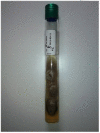Subcutaneous Phaeohyphomycosis Due to Pyrenochaeta romeroi Mimicking a Synovial Cyst
- PMID: 27630637
- PMCID: PMC5006011
- DOI: 10.3389/fmicb.2016.01405
Subcutaneous Phaeohyphomycosis Due to Pyrenochaeta romeroi Mimicking a Synovial Cyst
Abstract
Opportunistic subcutaneous fungal infections are increasing nowadays due to the growing number of medical conditions causing immunosuppression, especially organ transplant. The incidence rate of subcutaneous phaeohyphomycosis is very low. Most studies found are case reports. They showed a wide variation of clinical presentations. Pyrenochaeta romeroi, a fungus from the Dematiaceae group is a saprophyte found in soil and plants and a possible causative agent of phaeohyphomycosis. We present a rare case of subcutaneous phaeohyphomycosis caused by P. romeroi mimicking a synovial cyst in a diabetic patient.
Keywords: Pyrenochaeta; fungal infection; immunosuppression; phaeohyphomycosis; surgical treatment.
Figures




References
-
- Chowdhary A., Meis J. F., Guarro J., de Hoog G. S., Kathuria S., Arendrup M. C., et al. (2014). ESCMID and ECMM joint clinical guidelines for the diagnosis and management of systemic phaeohyphomycosis: diseases caused by black fungi. Clin. Microbiol. Infect. 20(Suppl. 3), 47–75. 10.1111/1469-0691.12515 - DOI - PubMed
LinkOut - more resources
Full Text Sources
Other Literature Sources

